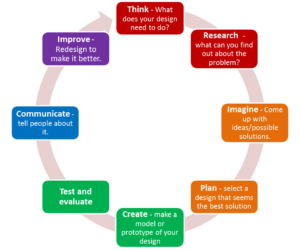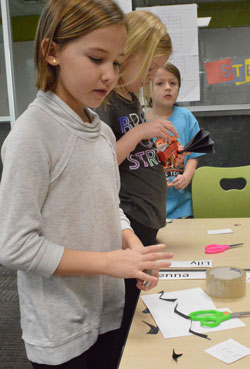“You Bet Your Friend,” a game created by Brown Elementary School second-graders Jenna VanderLaan, Lily VanHooren, Emma Boer, John Raddatz and Lucas DeBoer, could impress a game aficionado.
It features a dice launcher and a “dunker,” including a pulley system and mini-pool filled with blue styrofoam peanuts. Their game cards offer interesting ways to earn play money: turn cartwheels, do pushups or sit-ups, hold your breath.
“The hardest part was making the dunker work,” said Emma, who said she and her group had to “renovate” the game to make it work right. “I had to make it better so it would be the best it could be.”

Design-thinking, meet science, technology, engineering and math. In all three of the district’s elementary schools, students are busy inventing by using a step-by-step process that allows them to develop products like real designers would. They are casting their imaginations wide, and netting ideas through teamwork and innovation.
First-graders are making chairs out of cereal boxes, newspaper and tape; second-graders’ board games are multi-pieced and interactive; third-graders’ marble runs roll and turn; and fourth-graders’ arcade games became makeshift cardboard game galleries. Students learn to tinker, test and try again.
“It’s like making a prototype for a manufacturer,” said Brown Elementary STEM teacher Sherri Newenhouse.
Newenhouse, Marshall Elementary teacher Sandra Slentz and Countryside Elementary’s Kelly Behrens have incorporated design-thinking into their kindergarten through fourth-grade STEM classes, where even the youngest students are making their own puzzles. They use the process of think, research, imagine, plan, create, test and evaluate, communicate and improve. It’s similar to design-thinking used by innovators, but with more elementary-level language.

Testing Creations
In Behrens’ class, students created a bridge that could accommodate 21 toy cars after reading the book, “21 Elephants and Still Standing,” based on the building of the Brooklyn Bridge. After the bridge’s opening, P.T. Barnum eased people’s fears and proved its strength by parading 21 of his circus elephants across the bridge.
“It is so fun for me as a teacher to watch the kids work through the design process and see what they can dream up,” Behrens said. “From designs on paper, to turning everyday ‘junk’ into a functional bridge, to testing the durability of our creations, it is a joy to watch the kids get excited as they go through the process of creating.”
Newenhouse presents a challenge and has students ask questions like, “What do we want our game to be or marble run to look like?” Then she supplies tape, scissors cardboard and other materials and lets them go to work.
Part of the fun is playing each other’s games, and watching others figure out how to use their own creations.
“Even this morning playing with their groups, they see where there are problems, and they solve the problems while testing and playing and working together,” Newenhouse said.
For students Caden Weir, Alexander Witte, Kyle Naklizki and Zachary Foster, the problem was that they didn’t make enough squares for their Black Panther-inspired board game, “The Black Sorry,” for it to work. They added more to increase the challenge for players to make their way around the board. They also decided to turn their game pieces – eraser toppers – into characters named The Black Panther, Hulk, and Waterblaster.
“We were like, ‘What’s the fun in having just erasers when you can have The Black Panther?’” Alexander said.
CONNECT













